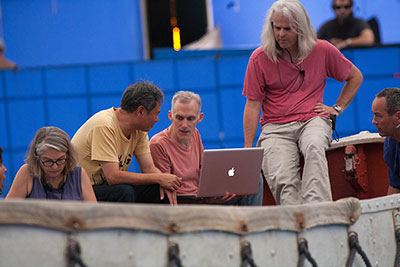Tim Squyres '81 – from fleeing physics to 'Life of Pi'
By Daniel Aloi

Two-time Academy Award nominee Tim Squyres ’81 can trace the beginning of his career as a film editor to a turning point when he was a Cornell student.
“I was starting to question my chosen major, which was physics, and started to cast around,” he said by phone from New York City. “Kind of on a whim, I knew there was a beginning film production class, so I enrolled and that was that. It was something I was happy to do 20 hours a day and not sleep, and that was a good sign.”
Squyres will introduce his latest work, “Life of Pi,” at a Cornell Cinema screening March 10 at 7:15 p.m. in Willard Straight Theatre. Squyres served on the Cornell Cinema Advisory Board in the early 1980s; he earned his Cornell degree in psychology and is the younger brother of Steve Squyres, the Goldwin Smith Professor of Astronomy.
“I became a teaching assistant for a summer class [in film] and did that for a couple years; I also worked at the public access station downtown,” he said. “There was a television studio in Martha Van Rensselaer Hall where they made public television educational films for New York state, and I did a lot of work there. I did sporting events, weddings, whatever I could find to do.”

After editing the independent film “Blowback,” Squyres began his long association with director Ang Lee in 1991. He earned Oscar nominations for his work editing Lee’s “Crouching Tiger, Hidden Dragon” in 2000 and “Life of Pi” this year. The 3-D adventure film (showing at Cornell in 2-D), about an Indian boy on his way to America who shares a lifeboat with a tiger following a shipwreck at sea, is his 11th collaboration with Lee; others include “The Ice Storm,” “Sense and Sensibility,” “Hulk,” “Ride with the Devil,” “Eat Drink Man Woman” and “Lust/Caution.”
Squyres said he appreciates the diversity of Lee’s work.
“The great thing is that there is variety,” he said. “I love not doing the same movie over and over again. To be able to do a martial arts film, and then do a comic book superhero film, and then a drama, and then a ‘Life of Pi,’ I love that. I’m always eager to see what’s next.”
Quantifying the work of an editor is not always easy, even as an editor himself, Squyres noted.
“It’s hard for an audience to put their finger on what the editor did,” he said. “Very often with editing, I go, ‘I really like the movie, so the editor must have done something right because he puts it all together. … You never want the editing to take you out of the story. If you have an engaging story you tend not to watch the editing, and that’s not a problem for me. ‘Life of Pi’ isn’t the type of film where you’re going to watch the editing. With such heavy visual effects, all the different parts are cooperating with each other more than usual.”
“Life of Pi” was filmed and edited entirely in 3-D.
“We took the 3-D format very seriously, not as a gimmick,” Squyres said. “We wore our 3-D glasses the whole time. The drawback to cutting in 3-D is you go home with a lot of headaches, but you develop a tolerance for it. To do it properly takes a lot of work. It was a very interesting learning process, and I think it adds a lot to the film.”
His next projects now in post-production are his second collaboration (after “Rachel Getting Married”) with director Jonathan Demme, “Wally and André Shoot Ibsen,” a sort-of-sequel to “My Dinner With André”; and a documentary on Lance Armstrong. “In light of more recent events, it’s gone through an overhaul,” he said.
Media Contact
Get Cornell news delivered right to your inbox.
Subscribe